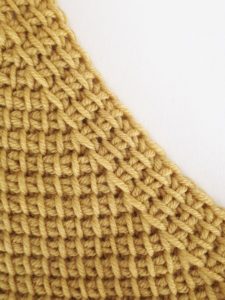On this page I show 7 examples of decreases in Tunisian crochet. The list is not exhaustive. There are other ways to make decreases at the start, in the middle and at the end of the rows.
To easily compare the differences between all samples presented here, I applied the following rules:
- All samples are made in the Tunisian simple stitch.
- Decreases are placed as from the 3rd stitch of each row and at every single row.
Decrease #1: skip 1 stitch
The easiest way to make a decrease of 1 stitch is to skip a stitch. This technique works with any kind of stitch. For the sample below, at each FwdP, I systematically skipped the 3rd vertical bar after the edge stitch.
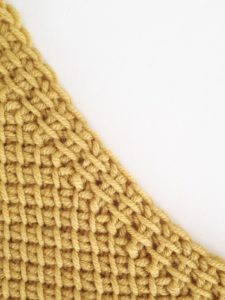
Decrease #2: 2 simple stitches together
You decrease by 1 stitch by inserting the hook under 2 vertical bars (instead of one). Make a yarn over and pull up a loop.
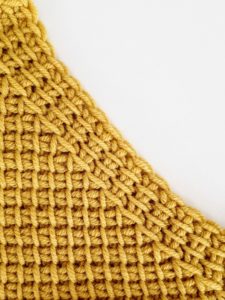
Decrease #3: 1 simple stitch and 1 knit stitch together
The hook is inserted under the front vertical bar (like for a simple stitch) AND in between the front and back vertical bars of the following stitch (like for a knit stitch). Then yarn over and pull up a loop.
In short, this type of decrease is exactly the same as decrease #2 but with a different visual effect. Have a look at the short (soundless) video I posted on my YouTube channel.
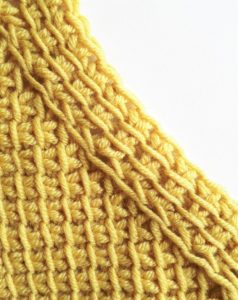
Decrease #4: 1 simple stitch under 1 slip stitch
Insert your hook under 2 vertical bars, then pull the second vertical bar under the first one, yarn over and pull up a loop.
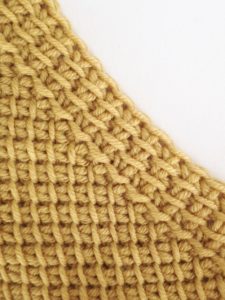
I don’t really know how to classify this type of decrease in Tunisian crochet. I have not found any documentation about it in books or on internet. Technically, we could consider the first vertical bar as a slip stitch and the second vertical bar as a simple stitch (but you pull the vertical bar under the slip stitch before making a yarn over and pulling up a loop). So it could be considered as a “2 stitches together”, like decreases #2 and #3. If we take it from a different viewpoint, we could consider this is a decrease by crossing 2 stitches together (a simple stitch is crossed with a slip stitch).
Anyway, I made a short soundless video to show how this decrease is made.
Decrease #5: 1 twisted up stitch under 1 slip stitch
This decrease is a variation of the previous decrease. Insert your hook under the front vertical bar, then grab the next vertical bar like you would for a twisted up stitch. Pull the second bar under the first vertical bar, yarn over and pull up a loop.
I posted a short soundless video (sans son) on my YouTube channel to show how this decrease is made.
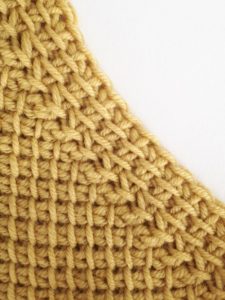
Decrease #6: pull the last picked up loop through the previous loop
The idea is to work all stitches in simple stitches, but at some point, to make a decrease by one stitch in the middle of the row, you pull the last picked up loop through the previous picked up loop.
The sample is made as follows: All rows start with 4 Tunisian simple stitches (Tss). You have 5 loops on your hook (the edge stitch and 4 Tss). Before picking up the next Tss, pull the last picked loop through the previous picked up loop. You have 4 loops left on hook (the edge stitch and 3 Tss). Keep on working in Tss for the rest of the row.
I posted a short soundless video to show how this decrease is made.
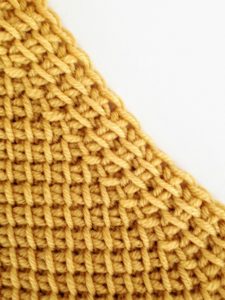
Decrease #7: Return pass – pull yarn through 3 loops
A “standard” RetP starts with 1 chain, then you make a yarn over and you pull yarn through 2 loops.
To decrease by 1 stitch on the RetP, instead of pulling yarn through 2 loops, pull it through 3 loops where you want to place your decrease. On the following FwdP, you’ll notice 2 vertical bars leaning towards each other. Consider these 2 bars as one unit, one stitch.
In a short soundless video I show how this decrease is made on the RetP. Pay attention to the following FwdP as well.
